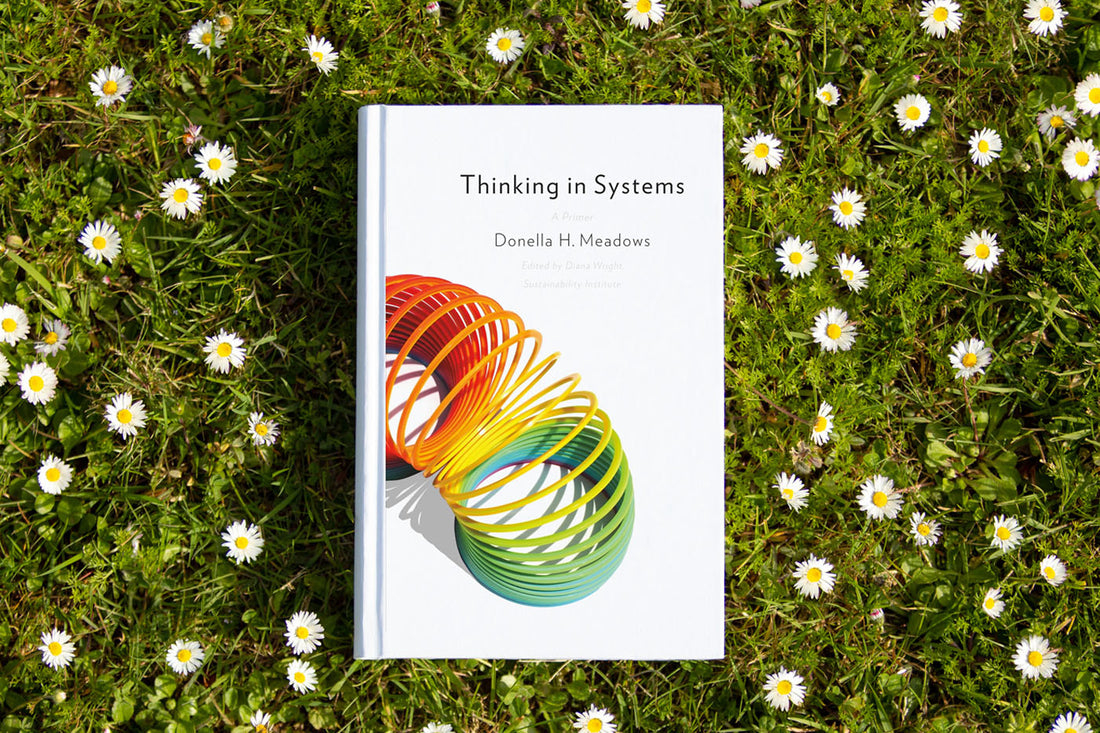
Wilde Hippi Book Club: Thinking in Systems by Donella H. Meadows
Share
Wilde Hippi Book Club, Thinking in Systems by Donella H. Meadows
It's been a while since my last Wilde Hippi Book Club entry. Life caught up; the second module of my Master's degree in Fashion Sustainability was incredibly demanding, both in terms of workload and focus. Additionally, the children were home for seven weeks during the school break. Academic demands and family commitments disrupted my usual reading routine.
One of the set texts for my course was Thinking in Systems by Donella H. Meadows. It replaced my "current read," so I thought I'd share it here instead. For someone as creative as I am, it's not the most captivating or poetic book; it leans more technical than I'd usually choose. However, once I got through it, I found myself looking at problems differently. The book equips you with a new lens, one that zooms out to see the connections and feedback loops that shape our world. And that's invaluable in the context of sustainable fashion.
A Quick Summary of the Book
Thinking in Systems introduces the concept of systems thinking, a way of seeing the world not as isolated parts, but as interconnected wholes. Meadows explains that systems are composed of elements, interconnections, and purposes. She highlights reinforcing and balancing feedback loops (the cycles that make systems grow, collapse, or stabilise), delays, resilience, and leverage points (places where small shifts can lead to significant change).
While she writes about everything from population growth to economic models, the more profound message is about humility and curiosity, that we can't "fix" systems overnight. Still, we can learn to see patterns, intervene wisely, and design with long-term resilience in mind.

Why This Matters for Fashion Sustainability
The fashion industry is a prime example of a complex system. It is a tangled web of production, consumption, culture, and waste. Once you start seeing it through Meadows' lens, the connections become clearer:
Feedback loops: Fast fashion speeds up demand, resulting in more cheap clothing being produced, which in turn leads to consumers expecting lower prices, and thus even faster cycles. Breaking this loop requires interventions such as slowing down production, offering repairs, or shifting consumer narratives.
Delays: There is often a gap between action and impact. For instance, brands may invest in "sustainable" materials now, but the benefits (or unintended consequences) may not be apparent until years later.
Leverage points: Meadows argues that the most effective change comes not from tinkering at the surface, but from shifting mindsets. In fashion, this means rethinking our values, moving from more to enough, from disposability to durability, and from individual trends to collective care.
This shift in perspective is at the heart of circular fashion and sustainable design, looking beyond one garment or collection and asking how the entire system can evolve.

How We Can Use Systems Thinking in Fashion
For designers, makers, and wearers, systems thinking can become a creative tool. Instead of focusing only on the garment in front of us, we can ask:
Where does this fabric originate, and where will it end up?
How does my design impact not just a consumer, but the workers, the supply chain, and the environment?
What stories are reinforced when we choose one material, one price point, one aesthetic over another?
The book may not sparkle with creative imagery, but its ideas are powerful. It reminds us that fashion is not just about clothes, it is about systems of belonging, resources, labour, identity, and ecology. And when we start to see those systems, we can imagine better ones.
Looking Ahead, Applying Systems Thinking to My Work
Reading Meadows has shifted the way I approach my own work in fashion sustainability. Living and working in Singapore adds a unique dimension to this journey. Here, dissent is often restricted, and public conversations around consumption, waste, and environmental care must be framed thoughtfully to resonate within cultural and political boundaries. That means systems thinking is not just practical, it is essential.
Rather than pushing against walls head-on, I've started to see the more innovative paths through the system. Minor leverage points can ripple outward in powerful ways, whether it is a workshop that sparks curiosity in children, a storytelling wall that invites quiet reflection, or a repair activity that feels like community bonding. Instead of calling for radical transformation outright, the focus becomes seeding small, interconnected changes that accumulate over time.
For me, that means designing creative interventions that educate indirectly, wrapping sustainability into experiences that feel communal, enjoyable, and culturally safe. It could be through fashion repair cafés in malls, dye gardens that connect people to nature in the city, or podcasts that open space for unheard voices. Each of these interventions uses fashion as an entry point, but the real aim is to shift mindsets, gently moving people from consumption to connection.
Meadows reminds us that the most lasting change happens when we shift the underlying values that drive behaviour. In fashion, these values often revolve around status, novelty, and speed. As I look ahead, I want to explore how we can replace them with different guiding principles, ones that highlight durability, care, and a sense of belonging. In Singapore, where efficiency and modernity shape much of the narrative, integrating ecological awareness and social care into fashion feels both challenging and significant.
So, while 'Thinking in Systems' might not be the kind of book I'd typically take to the beach, it has given me a framework I'll carry forward. A way of seeing that doesn't just analyse fashion as an industry, but recognises it as part of a living system, one that can evolve if we learn how to intervene wisely.
🌿🦋 Follow My Learning Journey
If you'd like to follow along, I'll be sharing weekly blog updates as part of my progress diary for my Master's in Fashion Sustainability. Each post reflects the hands-on experiences, lessons, and inspiration gathered on this journey toward a more conscious and connected way of living.
🌸🌱 Wilde Reads: Books For Change
So far, it's mostly been me reading and sharing reflections, but I'd love to turn Wilde Hippi Book Club into something shared. If you're passionate about sustainability and fashion, you may enjoy reading alongside me. Together we can explore books that spark new ideas, open conversations, and inspire more conscious ways of living.
We're now on our seventh read, Worn: A People's History of Clothing by Sofi Thanhauser. If this resonates with you, I'd be delighted to have you join me in turning the page towards a better world. 📚✨
With gratitude,
Tala 🌿💚
